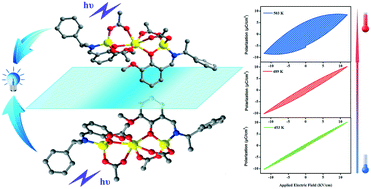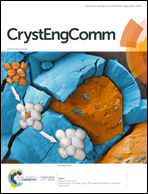A pair of homochiral trinuclear Zn(ii) clusters exhibiting unusual ferroelectric behaviour at high temperature†
Abstract
Molecular ferroelectrics as a class of promising information storage materials have triggered widespread attention owing to their light weight, easy processing and mechanical flexibility. However, reports of molecular ferroelectrics with high-temperature ferroelectric behaviour and higher spontaneous polarization are mainly focused on organic–inorganic perovskites, which are scarce in coordination compound avenues. Here, a pair of homochiral trinuclear Zn(II) clusters formulated as R-[Zn3(R–L)2(CH3COO)4] (R-1) and S-[Zn3(S–L)2(CH3COO)4] (S-1) were successfully constructed with zinc(II) and the enantiomeric chiral Schiff-base ligands (R/S)-HL (HL = 2-methoxy-6-[(1-phenyl-ethylimino)-methyl]-phenol) through a solvent diffusion method. The solid-state circular dichroism (CD) spectra perfectly illustrate the enantiomeric characteristics of R-1 and S-1. Interestingly, the trinuclear Zn(II) cluster (R-1) exhibits unusual high-temperature ferroelectric behaviour at 503 K, when the external electric field is 12 KV cm−1, and the remnant polarity (Pr) and spontaneous polarization (Ps) of R-1 can reach up to 5.4 μC cm−2 and 8.45 μC cm−2, respectively, which are comparable with organic–inorganic perovskite ferroelectrics in the literature. To the best of our knowledge, it is the first example of a high-temperature ferroelectric possessing higher spontaneous polarization in Zn-based molecular ferroelectrics.



 Please wait while we load your content...
Please wait while we load your content...